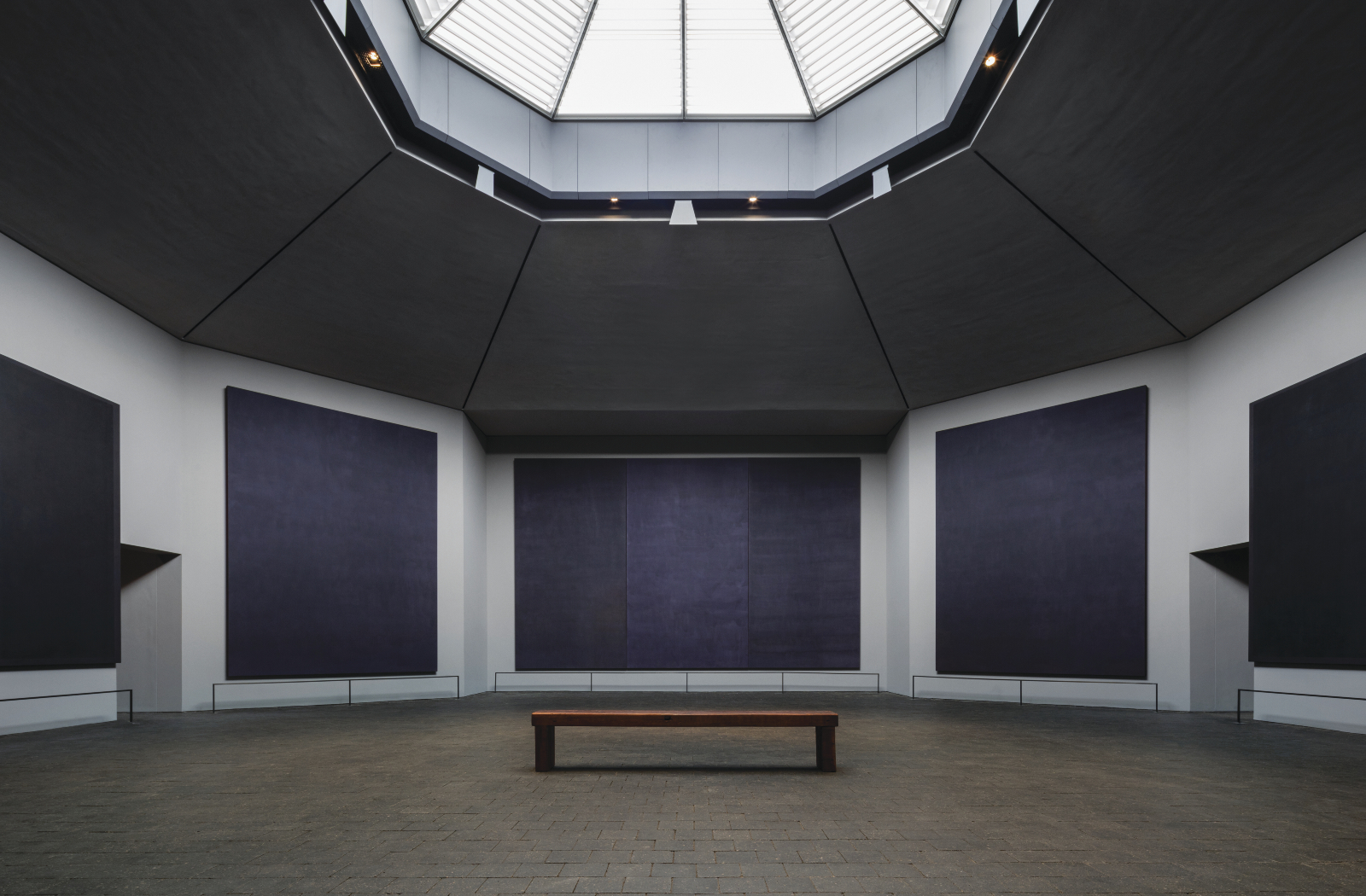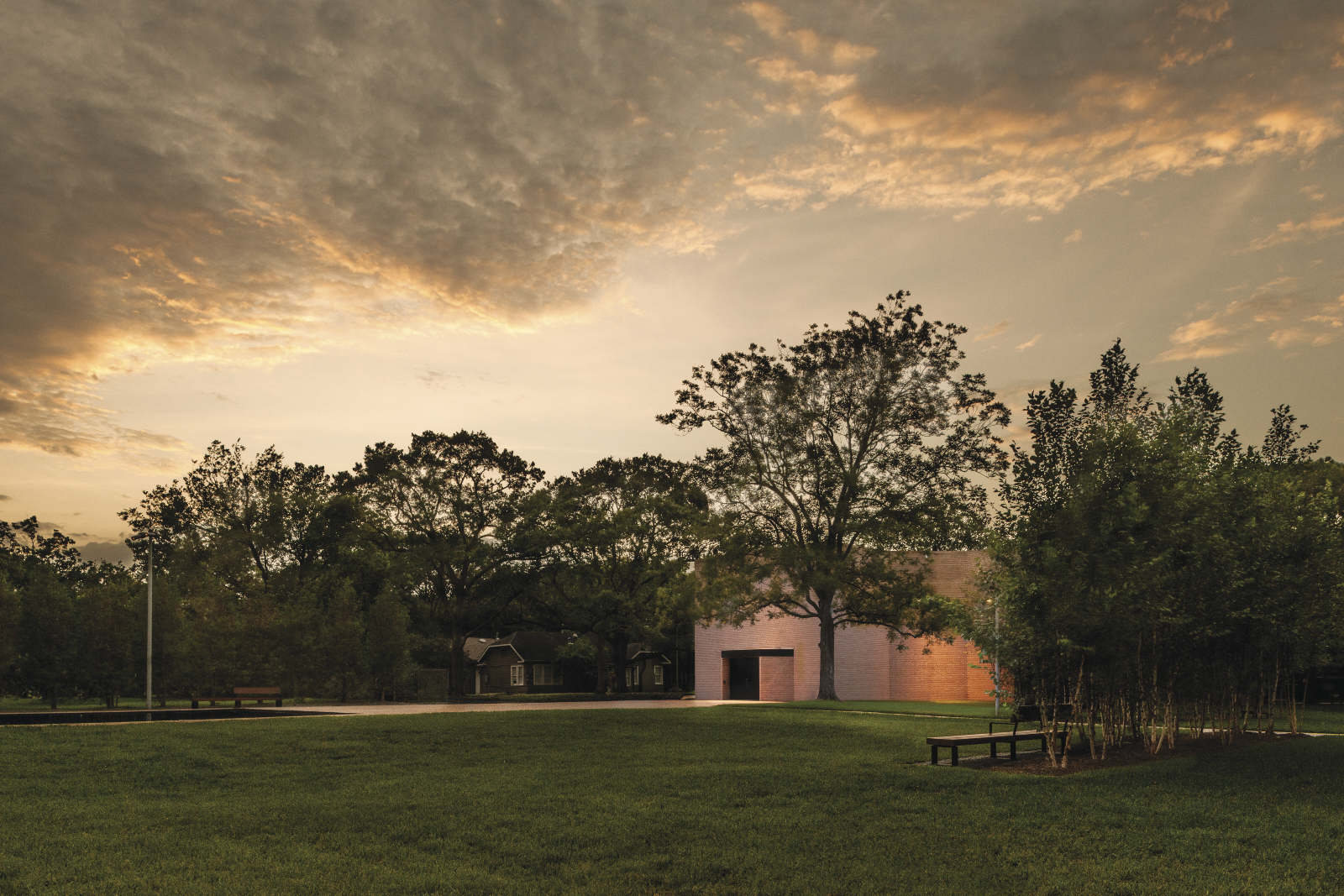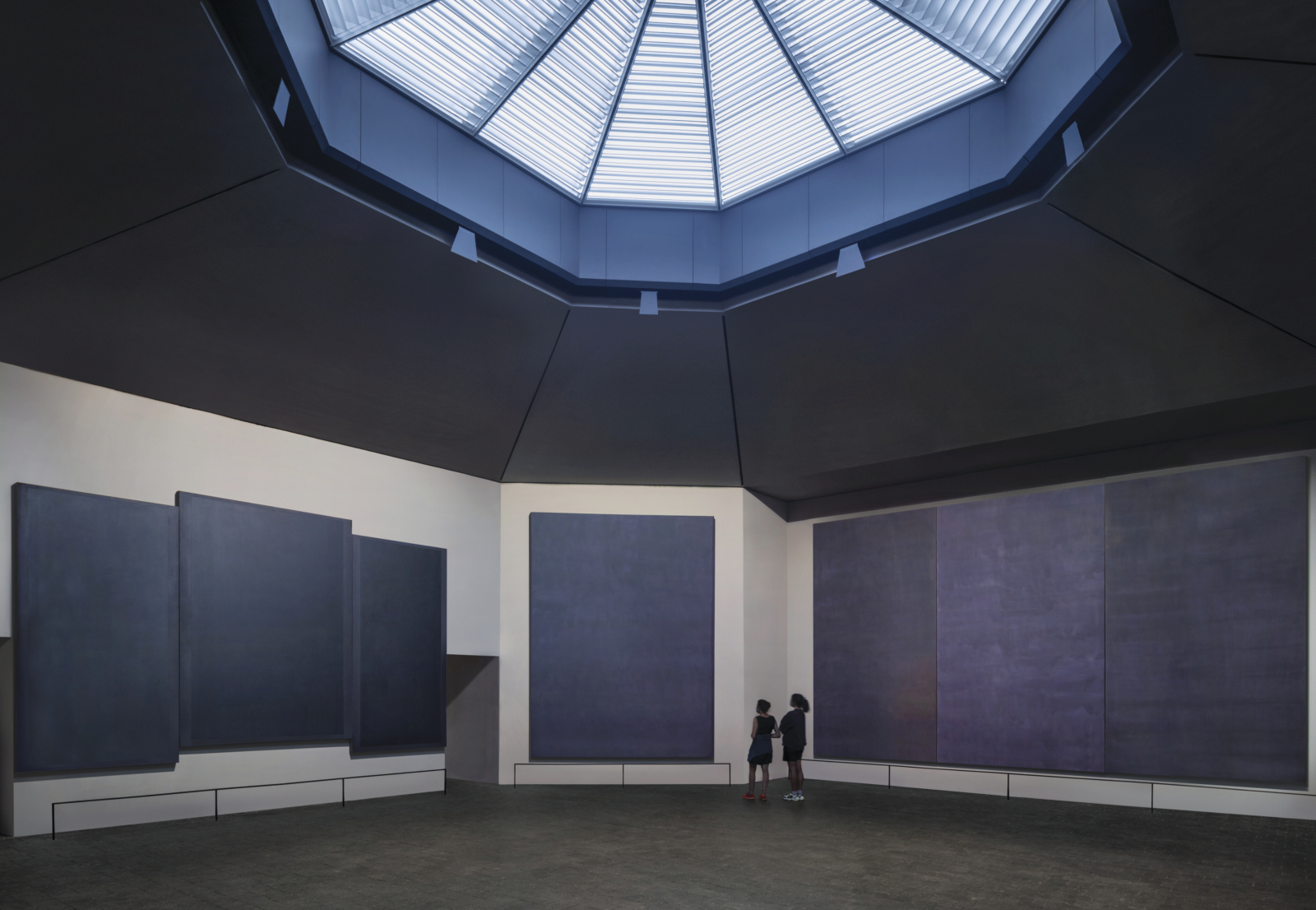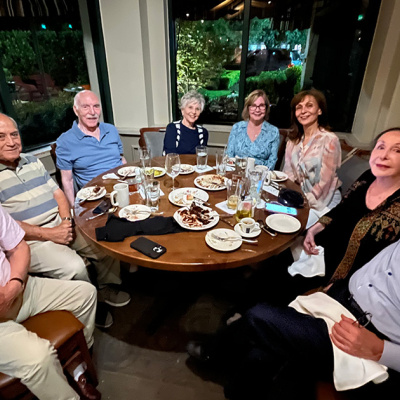Two Longhorns Lead the Charge on Reopening the Rothko Chapel

Walking through the lawn that separates the Menil Collection and its park to the east from the Rothko Chapel in Houston’s Montrose neighborhood, I am not particularly struck by the type of transcendent beauty for which I am told to prepare myself. There is a group doing yoga on the lawn, everyone spaced 6 feet apart on colorful mats. People read books and lower their masks to chat. A docent wanders around the main attraction, between the Chapel’s entrance and Barnett Newman’s “Broken Obelisk” sculpture outside. It’s all fairly serene and pleasant. But the building itself, one of the most important artworks in the country, isn’t remarkable to me at first; from the exterior it looks not unlike an elementary school gymnasium. Until I walk inside.
I enter a small, octagonal room made deceptively larger with high ceilings and a hypnotic skylight that vacillates in the amount of light it lets through as clouds pass overhead. This is the creation of Mark Rothko, the abstract expressionist painter whose hazy blocks of rectangular color came to define abstract modern art after World War II. Fourteen Rothko paintings surround the room, the largest of which are 15-by-11 feet, all of them dark yet textured and containing color hues. Some occupy their own walls and others are part of a triptych. From the back of the room, or from one of the four-—eight in non-COVID times—wooden benches that surround the room, even, each painting looks like a mass of darkness. Upon closer inspection, and as the sun radiates through the roof, the pieces embody both a distinctness and a cohesion. I see—and subsequently fixate on—cartoonish animals in each painting. I stare at a tiger before clouds transform it into a brontosaurus and back again. In my pictures from that day, I just see black and purple blocks, which is why the Rothko Chapel is one of the most alluring and important art spaces in the entire world. You have to be present inside the brick building, bathed in light and enveloped by Rothko’s creations.
I don’t have much with which to compare the revitalized Rothko Chapel, as my first visit to the space was in June 2019, when it was under renovation and closed to the public. Back then, the paintings had been crated and sent to an undisclosed location, scaffolding covered the inside of the building, and “Broken Obelisk” sat in a reflecting pool sucked dry. Last time, I wore a hardhat; today, I’m wearing a mask.
For 18 months, the Rothko Chapel sat unoccupied, as newly discovered structural issues and a worldwide pandemic made it unable to perform its core function. When the Houston community—and the world—needed it most, at the crossroads of a new civil rights movement and a virus that has upended society as we know it, the Rothko Chapel could not be a sanctuary for all comers.
As it celebrates its 50th anniversary, the Rothko Chapel and its surrounding campus looks different—though not unlike itself—thanks to a years-long renovation project spearheaded by a few UT Austin alumni, including the Chapel’s executive director and chair of its board of directors.
Face-lift aside, the Rothko Chapel and its surrounding campus is a mirror to the community; it is as its visitors are. Today, in late October, people making the pilgrimage are masked up and socially distanced. Visitors must book time on the Rothko Chapel website in 30-minute blocks, cover mouths and noses to enter, and refrain from gathering too closely. But they have finally made it back inside, which is the important part.

It’s difficult to categorize what exactly the Rothko Chapel is.
It’s not a museum, although enough Rothko paintings hang on its walls to classify it as such. It’s not a literal chapel, despite its name, the paintings’ crucifixion symbolism, and the de Menils’ Catholic adherence. “Broken Obelisk” is a call for social justice, dedicated to Martin Luther King Jr., but it rests outside the building, waiting for visitors near the Chapel’s exit alongside the bright Houston sun.
The Rothko Chapel exists at the intersection of all three and yet transcends these ideas just the same. It is a chamber of reflection but not inaction; a temple of spirituality without dogmatic religion; a collection of art that would lose its inherent meaning were it to be split up. In a way, it is a physical space meant to transport us to a metaphysical space. It is a collective community location and a bastion of solitude.
At least that’s how Rothko envisioned it when he started work on the paintings for the de Menil-commissioned Rothko Chapel in 1964. Though by the time it opened in February 1971, he had died by suicide in his Manhattan studio, his body discovered in a large pool of blood after an overdose on barbiturates, an artery in his right arm slashed with a razor. The artist never saw the chapel bearing his name. He never even stepped foot in Houston.
But like any great artist, he had a vision, one that is apparent in every minor detail, like the decision to allow visitors to nearly touch their noses to his works in order to commune with them. Today, as it was in 1971, the only obstacle to his priceless works are tiny metal barriers, no more than a foot or so off the ground.
While his work evolved over the course of his career, his art constantly evokes immediacy and intimacy. Born Markus Rothkowitz in what is modern-day Latvia, his family immigrated to America in 1913. He started painting seriously in 1925 in New York City, after dropping out of Yale. His earliest pieces were in a realistic style: landscapes, portraits, and in the mid-1930s, a famous series of lonely subway travelers on train platforms that evoked the artist’s sense of isolation in a modern urban environment. As the Nazis came to power in Europe and deportation rumors spread, Rothko became a U.S. citizen in 1938 and shortened his name in 1940. It was during this time, with a new identity, that Rothko ascended as an artist, experimenting with form and color. In this later, “classic” Rothko period of abstract expressionism, the artist was quoted as encouraging viewers to get as close to his oversized paintings as possible, to intentionally overwhelm themselves, to enter the unknown, and, ultimately, to transcend the self.
But in the years since its opening, the Rothko Chapel had come to embody an icier aesthetic. In 1999, the skylight, which had been deemed a liability to the paintings, was almost completely covered with a metal baffle, which darkened the space. Visitors no longer could experience change in light over the course of even a couple minutes. Extra lighting was added to the interior, but it wasn’t the same. Humidity was a problem, too, so two transparent barriers were placed on either side of the entrance to diffuse it. A welcome desk was eventually placed just past the double-doors, which became an eyesore.
The result was a Rothko Chapel that not only differed greatly from Rothko’s original vision, but also from his and the Chapel’s mission of openness and inclusion. So in 2015, two Longhorns set out to restore that vision, and set the Chapel’s course for the 21st century and beyond.
“We came up with the title Opening Spaces,” says David Leslie, BA ’82, executive director of the Rothko Chapel. “It turns out to be a great metaphor because it is literally opening space. It’s a place that forces you to open your mind. It forces you to open your heart.”
Leslie and Michael Piana, BS ’76, MBA ’78, Life Member, chair of the Rothko Chapel board of directors, lead the charge on the ongoing Opening Spaces campaign. Together they work with other members of the board, staff, volunteers, and campaign chair Christopher Rothko, Mark’s son, and have raised $16 million so far toward a goal of $30 million.
Piana says that as the Chapel neared its 50th anniversary, the board wanted to think about the next 50 years. The baffle problem was a glaring one, but if they were going to fix that, shouldn’t they improve the Chapel in other ways at the same time?
“We’re going to create a campus that’s more appealing and welcoming to folks to be able to go to our welcome house,” he says. “The gardens are going to be gorgeous. And then, from the engineering side, we had to address some of the typical use and problems, like flooding water.”
The goals were split into two phases. Phase 1 would include re-imagining the skylight, reconstruction of the entrance (including removing the welcome desk and humidity barriers), construction of a welcome center across the street, moving electrical and water utilities out of the chapel proper, and a redesign of the Chapel’s campus. Lanie McKinnon, MLA ’07, was on the team that won the bid to help with the campus. McKinnon works in the New York office of landscape architecture firm Nelson Byrd Woltz, but grew up just blocks from the Rothko Chapel, and visited it frequently growing up.
Many of the early conversations that McKinnon and her colleagues had with the Rothko Chapel staff and board revolved around unity and openness. The idea, drilled down to its simplest element was, “a chapel in the park,” which wasn’t the reality anymore. The grasslands surrounding the Chapel didn’t feel like a true extension of the space.
McKinnon and her team set out to unify the campus. They applied for a mid-block raised crosswalk so that the welcome center could live across the street but not feel like a separate experience. Of course they focused on soils and grasses and planted a lot of trees—river birches—but landscape architecture is more than just that.
“A common perception is that it’s about plants and grasses and sod,” she says. “There’s so much about how we envision people to use the space that’s crafted. We envisioned large groups working by the obelisk. Yoga in the park. We help choreograph an experience, and how that flow works is part of that choreography.”
In that way, they had to consider how people moved around the campus, where they parked, how they entered, how they left.
“It is so serene and calming and impactful; people have these spiritual, deep reactions in the space, between the sculpture and the paintings,” McKinnon says. “The campus site needed somewhere for visitors to hold them once they left the Chapel. They needed a moment to reflect and calm down, process what they’ve seen.”
The river birches are planted together tightly around meditative spaces, outdoor benches for solitary visitors, and a plaza for groups to commune before or after visiting the chapel.
“From day one, everybody has a place here,” McKinnon says. “Landscape is an extension of that. Everyone who visits, hopefully, can feel that they are welcome and have a niche they can occupy in the entire landscape.”
When I visit between Phase 1 and Phase 2, on a beautiful October weekday, the campus is as described; it is open yet unified with the Chapel. My original return visit, though, was scheduled for eight months earlier, before construction woes—and a worldwide catastrophe—delayed everything.

This is all like the famous saying: We make plans and the world’s health infrastructure collapses under the weight of the worst pandemic in a century.
The Rothko Chapel did not reopen in February 2020, but not because of COVID-19. After months of renovations to the chapel and the campus, Architecture Research Office, the architect of record who handled master plan and design development for the Chapel restoration and the new Suzanne Deal Booth Welcome House, came across a nightmarish discovery: the building wasn’t as structurally sound as originally thought, especially as climate change has led to stronger wind speeds, increased rain, and much more dangerous storm surges. Hurricane Harvey thankfully spared the Rothko Chapel, but the next one?
“Looking at hurricanes, with wind speeds of 160 miles an hour,” Leslie says, “our engineers and our consultants were saying that, without the steel reinforcement, if the wind hit the building at a certain angle, it could jeopardize the integrity of the building.”
After speaking with ARO’s Neil Patel, BArch ’07, and structural engineers, Chapel leadership decided they needed to install vertical channels of metal rebar throughout the hollow portions of the interior for safety and security. The decision delayed reopening plans into late spring, which was aided by nationwide lockdowns as the virus spread. Piana is a longtime chemical engineer and professor at UT who has overseen a multitude of construction projects at refineries and plants, so he is used to delays, though he couldn’t imagine that the exterior walls wouldn’t have rebar in them.
“I certainly didn’t anticipate the big structural work that we had to do. So that was disappointing,” he says. “And then when COVID came, you know, it was just like, Oh yeah, 2020.”
Leslie says that internally there was a moment when the crescendo among the staff, board, donors, and volunteers quickly nosedived.
“There was both a sense of anticipation on one hand with this kind of deflation for a moment,” he says. “You’ve got all this energy, all this anticipation. And it’s like, ‘Oh, by the way, we’re going to have to hold off another three months.’”
The Rothko Chapel officially reopened at the end of September. Usually there is no cap on the amount of people allowed inside, but that number has been around 15–20, and visitors have to make reservations online for 30-minute blocks. Some 45-minute blocks were added in late October to accommodate those who wish to meditate or stay inside for a longer period of time. Normally open seven days a week, the Chapel is closed Monday and Tuesday for the time being.
Everything Rothko made and chose himself is still there: the paintings, wooden benches, and the pavers inspired by Central Park remain unaltered. But much of what sprang up in the interim period between Rothko’s suicide and today—anything that clouded the painter’s original vision—is gone.
The metal baffle that blocked the skylight, reducing the light aperture to a tiny circle is no more, and a new skylight, one that protects Rothko’s paintings from sun damage but allows light to flood in, has been installed. The bulky welcome desk that bifurcated the main room is gone. The odd-looking entrance has been replaced. It’s all addition by subtraction. The important thing, I am told, is that these changes are meant not to be visible but to be felt.
Leslie says that—and he promises this isn’t hyperbole—he’s had people moved to tears since the Chapel reopened. He posits that the pandemic has left many people feeling isolated, and that the Rothko Chapel opening again has become a haven for visitors. Leslie also says he has already heard multiple comments from visitors praising their increased emotional experience in the restored space.
“I’ll ask why and the answer tends to be, ‘I feel like I’m more fully engaged. There’s less impediment between me and the space and the art,’” Leslie says. “I haven’t heard anybody say, ‘Well, I see the paintings too clearly now,’ or, ‘Gosh, I really miss that heavy baffle hanging over me right now.’”
The relief for everyone involved is that the Chapel can remain open as Phase 2 rolls along. The adjacent gray bungalows that house the administrative building and the Rothko Chapel archives—including important handwritten notes and diagrams that architects used to restore the building and campus during Phase 1—are being relocated to make way for a meditation garden. A new programming building will be erected as a way to increase the amount of events they can hold around issues central to the Chapel’s mission.
Already underway, the Rothko Chapel is celebrating its 50th anniversary through June of this year with events on Martin Luther King Jr.’s birthday, a series of programs commemorating the 1971 dedication in February, and a symposium on civil rights in America in the spring. It is a celebration of the Rothko Chapel and all it means to the 100,000 people who visit it every (normal) year.
The way things are going, plans will likely have to change. International travel will be sparser than anticipated, meaning fewer visitors making their pilgrimage to the site. The people who do make it out—who are lucky enough to be included—will wear masks and create distance from each other, a strange sight in light of the Chapel’s core tenets of unity and inclusion. But at the very least, they will all have somewhere transcendent to be.
Photographs, from top: Elizabeth Fellcella; Paul Hester; Elizabeth Fellcella






